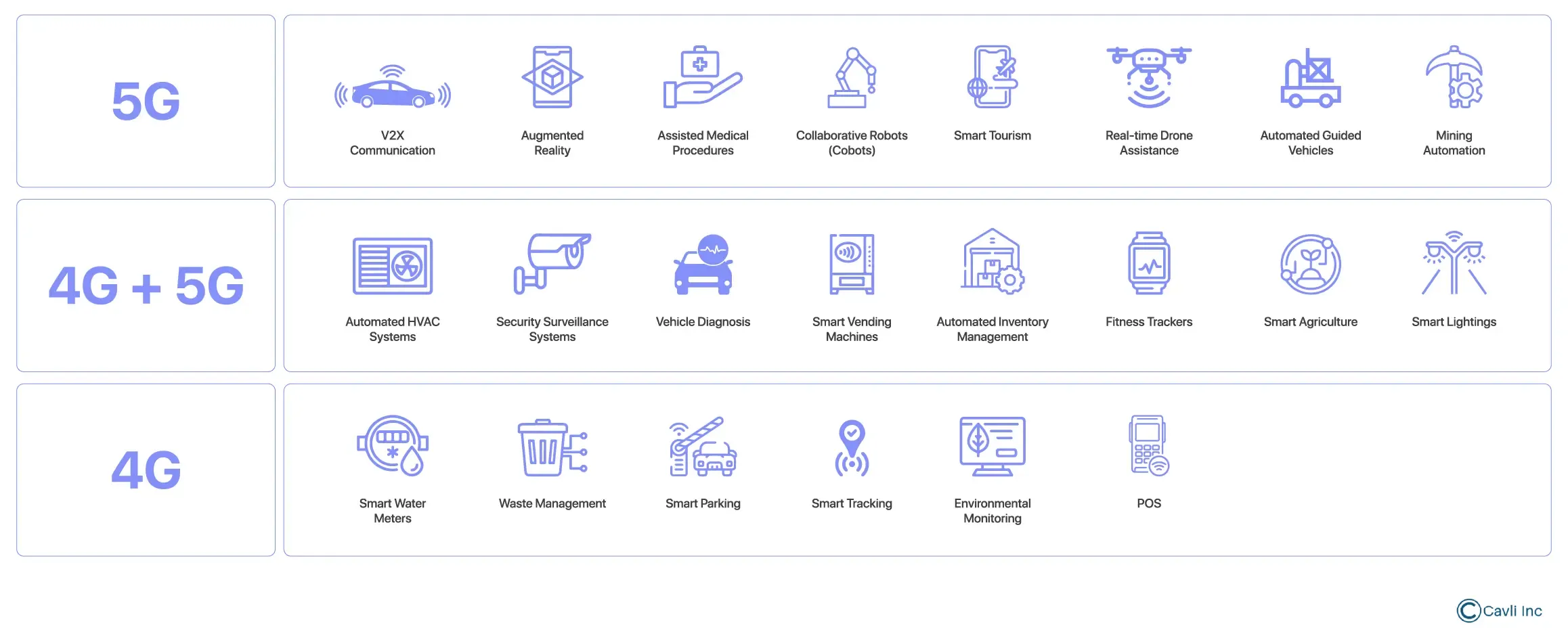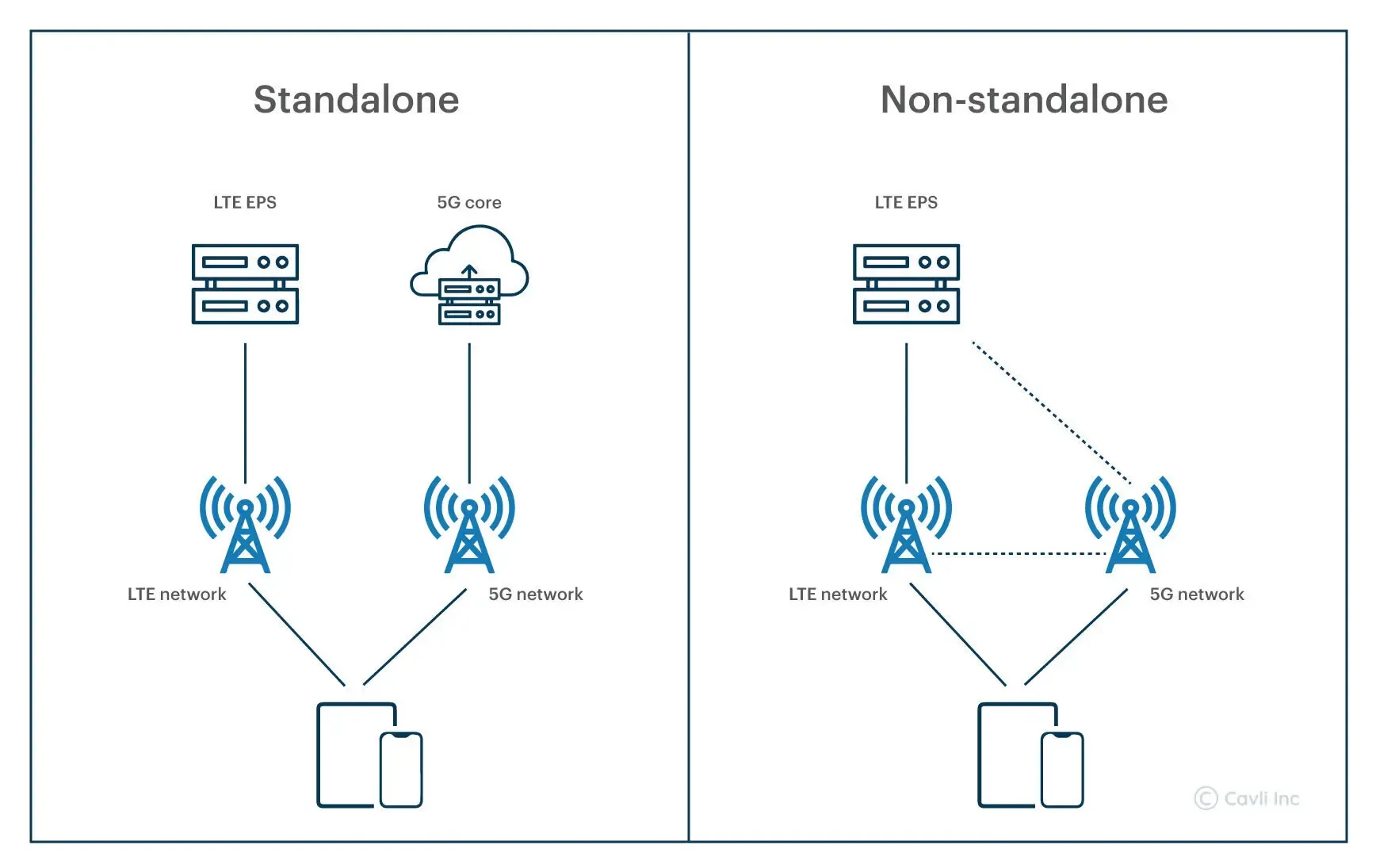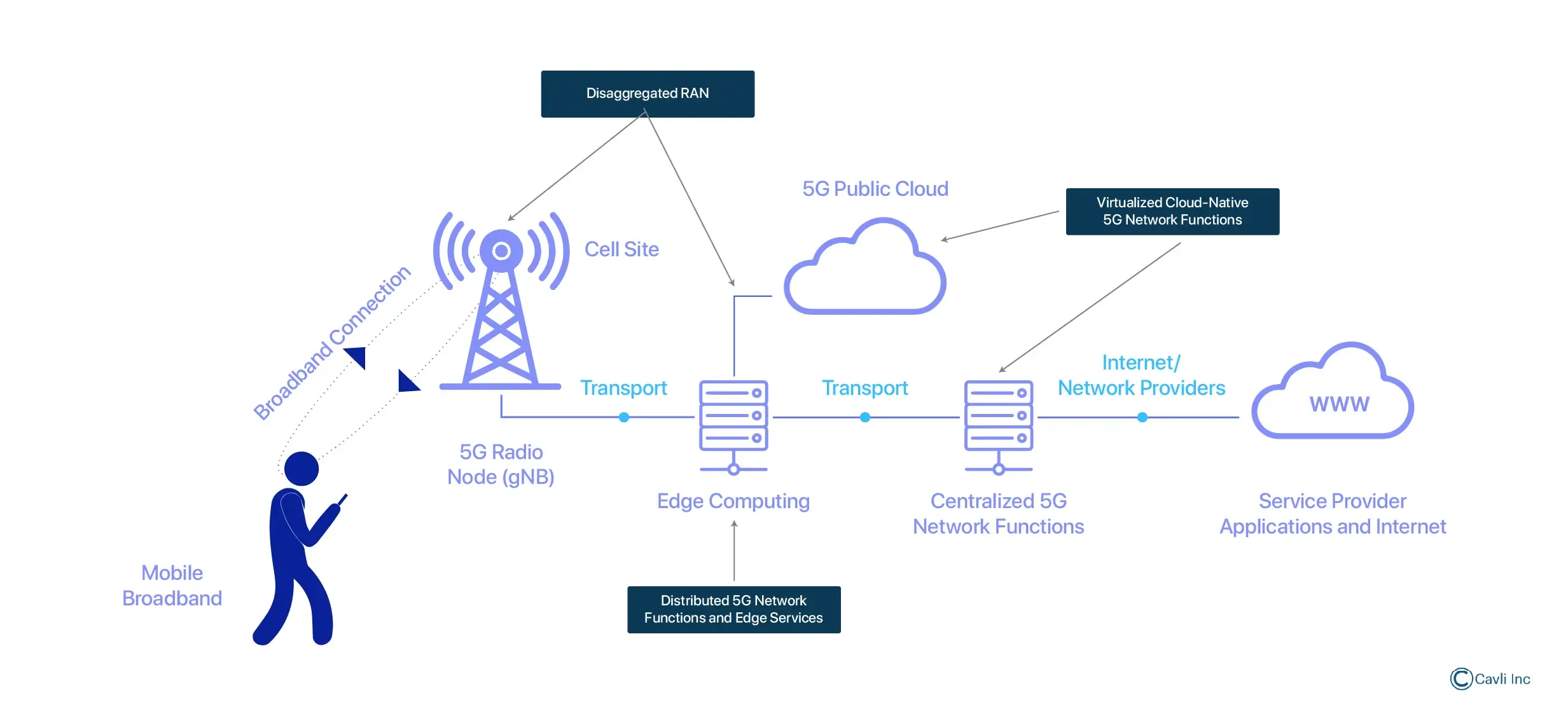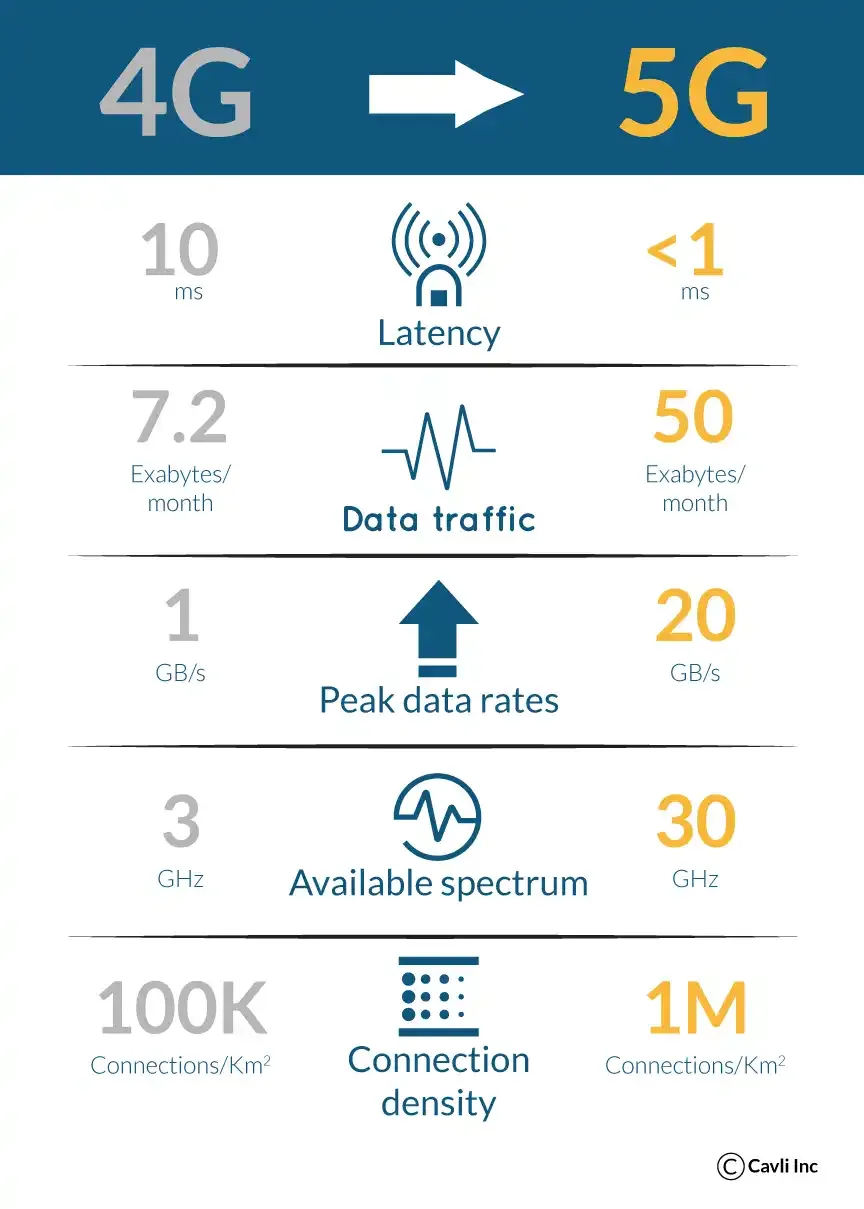The introduction of 5G technology marks a transformative shift in telecommunications, raising key questions such as “Is 5G better than LTE?” and how it compares to existing 4G networks. With its potential to offer ultra-fast speeds, near-zero latency, and the ability to connect billions of devices, 5G is poised to revolutionize how we communicate and interact with technology.
The shift from 4G to 5G represents a pivotal moment in network evolution. As the differences between 5G and 4G become increasingly clear, it is evident that 5G offers vast improvements in speed, latency, and network capacity. While much attention is turning toward the future of 6G, understanding the difference between 4G and 5G is essential for leveraging the current and upcoming capabilities of modern wireless networks. This blog explores the lte vs 5g debate and dives into the enhanced capabilities 5G brings beyond the 4g network we have relied on for years.
When considering whether 5G or LTE is the better option, it largely depends on specific use cases. However, a closer look at lte vs 5g shows that 5G offers much faster speeds, lower latency, and a greater ability to handle more connected devices, making it the ideal choice for next-generation applications such as IoT, smart cities, and autonomous vehicles.
Sunsetting of 3G Technology
3G technology was introduced in 3GPP Release 99 (1999), marking a revolution in mobile communication by enabling mobile internet and multimedia services beyond basic voice and SMS, thus laying the foundation for today’s connected world.
The following milestones highlight the evolution of UMTS (Universal Mobile Telecommunications System), the third-generation mobile technology:
Release 99 (Original UMTS):
- First UMTS standard
- Data rates up to 384 kbps
- Used WCDMA air interface
Release 5: HSDPA (High-Speed Downlink Packet Access)
- Enhanced downlink speeds up to 14.4 Mbps
- Also known as 3.5G
Release 6: HSUPA (High-Speed Uplink Packet Access)
- Enhanced uplink speeds up to 5.76 Mbps
- Combined with HSDPA, known as HSPA
Release 7/8: HSPA+ (Evolved High-Speed Packet Access)
- Also known as 3.75G or 3.9G
- Theoretical speeds up to 42 Mbps downlink
These 3G networks provided widespread mobile internet access, enabling browsing, email, and multimedia messaging (MMS) on mobile devices. However, as connectivity demands grew, 4g speed and network capabilities became necessary to meet modern needs.
The limitations of 3G in speed, capacity, and efficiency paved the way for faster standards — 4G and eventually 5G.
The sunsetting of 3G networks is a critical step in evolving telecom infrastructure, with operators repurposing 3G spectrum to enhance 4G networks and prepare for 5G deployments.
What is 4G Network? Exploring 4G Speed and Technology
The 3GPP (3rd Generation Partnership Project) released the 4G wireless network technology in Release 8 of December 2008. This release defined LTE technology, laying the foundation for modern 4G networks.
The breakthrough of 4th Generation network technology brought capabilities far superior to its 3G and 2G predecessors. Offering 4G speeds of up to 100 Mbps theoretically, latency between 20-50 milliseconds, and enhanced reliability, 4G networks enabled HD video streaming, mobile gaming, and faster browsing.
4G LTE (Long-Term Evolution) operates on packet-switching, allowing more efficient bandwidth use for data-heavy applications like streaming and gaming.
Beyond consumer use, 4G networks have been instrumental for IoT and M2M applications, supporting the connectivity of countless devices that communicate for industrial and automation purposes.
In 2011, 3GPP Release 10 introduced LTE-Advanced, meeting ITU's 4G criteria for higher data rates, improved spectral efficiency, and carrier aggregation, spawning LTE categories such as LTE Cat 1, Cat 4, and Cat 6.
Everything You Need to Know About LTE vs 5G

5G Networks v/s 4G LTE
For instance, imagine a manufacturing enterprise that relies on Wi-Fi and 4G networks for its daily operations. While functional, their network struggles with frequent latency issues, limited device connectivity, and occasional downtime that disrupts real-time operations and data analysis.
The case is no different for our elderly generation, many of whom still rely on 4G or basic keypad phones. While these devices serve their primarily calling and texting needs, they miss out on the transformative benefits of 5G, such as high-speed video calls with family, instant access to telehealth services, and real-time navigation updates that can greatly enhance their mobility and safety.
Now, you would also be curious to know how respective sectors can leverage 5G technology for better operational efficiency and network reliability.
What is 5G? How 5G is Better than LTE and 4G
5th Generation Network Technology was released in the 3GPP Release 15 in June 2018 focusing on the 5G Non-Standalone mode of operation. It leverages the existing 4G infrastructure (towers and base stations) without spending a considerable cost.
5G, the fifth generation of mobile network technology, offers significant improvements over its predecessors. By utilizing higher frequency bands like millimeter waves and sub-6GHz, it allows faster data transmission. 5G networks also employ massive MIMO technology and other advanced technologies to transmit and receive data in real time with enhanced capacity.
5G significantly reduces response times compared to 4G, enabling real-time communication necessary for critical applications such as remote surgeries and self-driving cars. When comparing LTE vs 5G in industrial applications, 5G offers far more adaptability. The differences in 5G vs 4G are evident in features like network slicing, which allows the network to allocate dedicated resources for specific use cases like IoT in smart cities or real-time data analytics in manufacturing. This flexibility and scalability make 5G the preferred choice over LTE for industries that require high-performance networks.
With 5G dominant mobile access technology, the congestion over the networks is eliminated, enabling users to experience higher speed, less latency, limited interference, and enhanced efficiency.
5G mid-band networks are considered a soft spot for achieving better coverage and network capacity with all user activities having an average time-to-content of less than 1.5 seconds. 5G has turned out to be the best candidate for different slices of IoT applications.
Learn in Detail: 5G Non-Standalone and 5G Standalone Deployment of 5G Networks

5G Non-Standalone and 5G Standalone Deployment of 5G Networks
5G Non-Standalone or 5G NSA
When we look at 5G NSA vs 5G SA, the key difference is in how each handles network deployment. 5G Non-Standalone (NSA) uses existing 4G infrastructure to anchor 5G networks, while 5G Standalone (SA) is a full 5G network that operates independently of 4G, offering enhanced performance for real-time applications. This means 5G NSA deployments are basically a combination of the existing 4G LTE architecture with 5G RAN, making it the easiest deployment option for optimizing the available 4G infrastructure.
Hybrid Deployment of 5G NSA
In the current situation, most of the 5G deployments happen in the hybrid mode, i.e., most of the carriers may switch to new 5G equipment, but the core remains 4G Evolved Packet Core.
What is 4G EPC?
The 5G RAN operating on the legacy 4G LTE is known as 4G EPC or 4G Evolved Packet Core. 4G EPC is a fundamental component of the 4G LTE network, efficiently managing data routing, mobility management, QoS, and security. It plays a critical role in managing user data and signaling traffic efficiently, ensuring efficient communication between user devices and the internet or other networks.
This core helps in providing high-speed IP-based internet access for a variety of services like HD streaming, VoLTE communications, and other applications. It is also responsible for managing data and signaling traffic across the network.
Functions of 4G EPC in 5G NSA Deployments
- In 5G NSA deployments, the EPC is still utilized, but with some enhancements to support the new 5G New Radio (NR) technology.
- NSA deployments showcase dual connectivity, allowing devices to connect to both 4G LTE and 5G NR simultaneously. With EPC managing these connections, dual connectivity becomes necessary for maintaining seamless service continuity as users move between 4G and 5G coverage areas.
- EPC supports a full IP-based communication architecture, simplifying network operations, reducing latency, and enabling more flexible service deployment when compared to older circuit-switched networks.
- EPC allows for dynamic QoS management, ensuring different types of traffic (e.g., voice, video, data) are handled according to their specific needs, improving the user experience.
- EPC’s modular architecture allows for scalable deployment, supporting the addition of new services and functionalities, such as VoLTE or VoNR, IoT-specific optimizations, and early integration with 5G networks.
Role of 5G RAN in 5G NSA
5G RAN (Radio Access Network) is a critical component of the 5G network. It is responsible for connecting end-user devices (smartphones, IoT devices, etc.) to the broader telecom network. It facilitates wireless communication between user equipment (UE) and the core network, enabling the transmission of data, voice, and other services.
- 5G RAN uses 5G NR technology consisting of sub-6 GHz (mid-band) and millimeter-wave (mmWave) bands, allowing significantly higher data rates, lower latency, and improved capacity.
- It supports licensed, unlicensed, and shared spectrum, enabling network operators to utilize existing and new spectrum assets more efficiently for reliable communication.
- 5G RAN leverages network slicing in full capacity, which allows network operators to create multiple virtual networks over a single physical infrastructure. Each slice can be tailored to meet specific requirements, such as high bandwidth for enhanced mobile broadband or low latency for critical IoT applications.
- 5G RAN provides flexible deployment architectures—centralized RAN (C-RAN) and distributed RAN (D-RAN). C-RAN centralizes baseband processing functions, improving efficiency and simplifying upgrades, while D-RAN keeps processing at the cell site.
- There is also a newer approach, Open RAN (O-RAN), which promotes interoperability between different vendors' equipment, allowing operators to mix and match components from different suppliers.
Limitations of 5G NSA Using 4G LTE Core
In 5G NSA, although these components enhance the performance, it can only enable 5G-equipped endpoints to receive some but not all benefits of 5G. It only provides higher connection speed, improved latency, and increased capacity.
5G NSA using 4G LTE Core cannot offer 5G capability beyond radio connectivity, i.e., while the air interface between the network and devices is upgraded to 5G, the core capabilities are limited, reducing the 5G potential to only establishing the radio link between UE and base stations. Therefore, 5G NSA can only be seen as a bridging technology in the transition to 5G SA.
Disadvantages of 5G Non-Standalone
- Dependency on 4G Core (EPC): The monolithic 4G core infrastructure creates bottlenecks in performance in 5G NSA, particularly when handling higher data rates and device density expected with 5G.
- Inefficient resource allocation: NSA employs both 4G and 5G networks. This leads to inefficient use of spectrum and resources as the 4G network still handles some of the control plane functions. Also managing the dual connectivity adds complexity, leading to suboptimal resource allocation and increased operational costs for network operators.
- Reduced Energy Efficiency: NSA's dual connectivity and reliance on 4G infrastructure also lead to higher power consumption compared to 5G SA, which is optimized for energy efficiency through advanced sleep modes and more efficient use of resources. The increased power usage of NSA networks can also contribute to higher operational costs and a larger carbon footprint.
- Lack of end-to-end network slicing: While 5G NSA supports only basic network slicing, it lacks the full end-to-end slicing capability of 5G SA. This restricts the ability to customize virtual networks and tailor them to specific service requirements. This reduces the flexibility and efficiency of the 5G NSA network. It also reduces the service quality of critical applications that require dedicated network resources.
5G Standalone or 5G SA

5G Standalone or 5G SA
- When talking about 5G standalone, the core is converted into a cloud-native 5G core along with 5G RAN. With a 5G compliant core and RAN, now 5G networks can realize the full capabilities of 5G networks.
- 5G SA deployment helps to connect 5G devices like mobile phones, hotspots, cars, and fixed wireless modems with the broad spectrum including mmWave and Sub 6-GHz to the respective base stations (gNodeB (gNB)). 5G networks also incorporate small cells in the network for limiting the congestion and seamlessly distributing traffic over the network.
- 5G Standalone or 5G SA is a cellular infrastructure built for 5G services to incorporate 5G standards and protocols. 5G SA stands for an end-to-end true 5G network employing 5G network core and 5G radio network. 5G SA is theoretically found to support connection density of 1 million devices over 1 square kilometer.
What all advantages does 5G Standalone get from cloud native 5G core?
Advantages of 5G Standalone
- Service-based Architecture (SBA): The 5G Core is based on a service-based architecture where network functions are modular, unlike the monolithic structure of the 4G core and can be deployed as independent services. This flexibility allows operators to limit the time in introducing new services, scale specific functions independently, and update individual components with nearly no downtime. SBA promotes interoperability between network functions through standardized APIs, making it easier to integrate and communicate within the network.
- Cloud-native Design: The cloud-native 5G Core can dynamically scale resources up or down based on demand, using containerization and orchestration platforms like Kubernetes. Microservices-based deployment helps improve the resilience of the network, leading to efficient resource allocation and cost savings, especially during peak usage periods or for specific services. Even if any service fails, it doesn’t bring down the entire system, ensuring reduced downtime and more robust network performance.
- Customizable network slices: 5G Core enables network slicing, which allows operators to create multiple virtual networks over a single physical infrastructure, each optimized for specific use cases (e.g., high bandwidth for enhanced mobile broadband, low latency for URLLC). The 5G core has end-to-end slicing capabilities, allowing a comprehensive, application-specific slice that extends across the RAN, transport channels, and core.
- Lower Latency and Improved Performance: The 5G Core is designed to minimize latency with more direct routing paths and the ability to bring data processing closer to the user through edge computing integration, significantly improving response times. By leveraging advanced features like user plane function (UPF) separation, the 5G Core can handle higher data throughput, enhancing overall network performance.
- Edge-Centric Architecture: The 5G Core supports seamless integration with Multi-access Edge Computing (MEC), enabling low-latency services for processing data closer to the end-user, which is crucial for applications like AR/VR, autonomous driving, and industrial automation.
LTE vs 5G: Key Differences Between 4G and 5G Networks Explained
| Parameter | 4G | 5G |
|---|---|---|
| Standard | Fourth Generation technology | Fifth Generation technology |
| Initiation from Year | 2010 | 2015 |
| Core Network | All IP network | 5G network interfacing (5G-NI) |
| Standards | All access convergence including OFDMA, MC-CDMA, network-LMPS | CDMA and BDMA (Beam Division Multiple Access) |
| Technologies | Unified IP, seamless integration of broadband LAN/WAN/PAN and WLAN | Unified IP, seamless integration of broadband LAN/WAN/PAN/WLAN and advanced technologies based on OFDM |
| Service | Dynamic information access, wearables, HD streaming, global roaming | Real-time information access, wearable devices, HD streaming, and more |
| Multiple Access | CDMA | CDMA, BDMA |
| Device Differentiation | Differentiation between fixed and mobile devices cannot be done. | Differentiation possible with cognitive radio techniques |
| Peak Data Rate | 1 Gbps (DL) | 20 Gbps (DL) |
| User Experienced Data Rate | 10 Mbps | 100 Mbps |
| Areal Traffic Capacity | 0.1 Mbps/m² | 10 Mbps/m² |
| Latency | 10 ms | 1 ms |
| Cell Capacity | 100 Mbps to 1 Gbps | 1 Gbps to 20 Gbps |
| Network Capacity | 10–20 Gbps per square kilometer | 100–1,000 Gbps per square kilometer |
| Connection Density | 100,000 devices/km² | 1,000,000 devices/km² |
| Mobility | Up to 350 km/h | Up to 500 km/h |
| Bandwidth | Up to 20 MHz | Up to 1 GHz |
| Upload Rate | 500 Mbps | 1.25 Gbps |
| Download Rate | 1 Gbps | 2.5 Gbps |
| Data Bandwidth | 2 Mbps - 1 Gbps | 1 Gbps and higher according to requirement |
| TTI (Transmission Time Interval) | 1 ms | Varying (100 µs (min.) to 4 ms (max.)) |
| Frequency Band | 2 - 8 GHz | 3 - 300 GHz |
| Network Architecture | Monolithic architecture with centralized control and processing | Software-defined, cloud-native architecture, focused on virtualization and scalability |
| Modulation Techniques | OFDM with limited flexibility | OFDM with flexible sub-carrier spacing for different frequency bands |
| Carrier Aggregation | Supports carrier aggregation but limited in scope | Advanced carrier aggregation techniques with support for multiple carriers |
| Massive MIMO | Supports MIMO up to 8x8 in high-end configurations | Massive MIMO with configurations like 64x64 or higher, boosting data throughput |
| Network Slicing | Limited capabilities | Full support for network slicing, creating optimized virtual networks for different use cases |
| Beamforming | Basic beamforming in LTE configurations | Advanced beamforming using phased arrays for enhanced signal strength and targeted coverage |
| Security Enhancements | LTE security standards with enhanced encryption for voice and data | Stronger security features like SUCI, enhanced mutual authentication, and secure access management |
| Edge Computing Support | Limited support for Mobile Edge Computing (MEC) | Full integration with Multi-Access Edge Computing (MEC) for low-latency data processing closer to end-user |
| Backhaul Requirements | Lower demands for backhaul capacity | Enhanced backhaul infrastructure needed to support high-speed data and low-latency requirements |
| QoS Management | Basic QoS management with predefined quality classes | Advanced QoS framework with dynamic, real-time adjustments and integration with network slicing |
| Spectrum Sharing | Dedicated LTE spectrum | Advanced dynamic spectrum sharing (DSS) for shared use of 4G and 5G bands |
| Interference Management | Interference management through frequency planning and scheduling | Advanced management through CoMP, dynamic beam selection, and interference cancellation techniques |
| Energy Efficiency | Standard sleep and idle modes | Enhanced energy efficiency with advanced sleep cycles and optimized power consumption |
| Handovers | Traditional LTE-LTE and LTE-Wi-Fi handovers | Seamless handovers with multi-RAT and tight integration with Wi-Fi 6 |
Is 5G Better than LTE? A Detailed Comparison of 4G vs 5G

How is 5G Technology Better than 4G networks
Speed and Capacity
- 5G utilizes a new radio interface technology called 5G NR, designed for higher bandwidth and improved efficiency compared to LTE used in 4G. 5G NR allows for combining multiple frequency bands simultaneously, effectively increasing the available bandwidth for data transmission.
- 5G employs denser antenna arrays for both base stations and user equipment with massive MIMO, enabling more efficient transmission and reception of data streams.
Latency
- In the comparison of 5G vs 4G speed, 5G clearly takes the lead with download speeds of up to 20 Gbps, significantly outpacing 4G, which has a maximum of 1 Gbps. One of the most notable differences in 5G vs 4G latency is the drastic reduction: 5G can achieve latencies as low as 1 millisecond, which is crucial for real-time applications like remote surgery and autonomous driving. Furthermore, 5G employs a shorter air interface and transmission frames compared to 4G, minimizing the time it takes for data to travel between devices and networks.
- 5G allows technologies like Network Slicing i.e., virtualizing the network and creating dedicated slices with specific latency guarantees for different applications, prioritizing real-time services.
Spectrum Efficiency
- 5G employs beamforming techniques that focus radio signals toward specific user devices, reducing interference and improving efficiency.
- 5G utilizes more advanced modulation schemes like higher-order Quadrature Amplitude Modulation (QAM) to pack more data into each transmission packet.
Closing Notes
The introduction of 5G Technology has implemented various advanced technologies that enhanced the capabilities of the present cellular networks. While 4G revolutionized mobile connectivity, 5G takes it a step further, offering blazing-fast speeds, and near-instantaneous response times, with the potential to transform industries. As 5G infrastructure expands and technology matures, it promises to usher in a new era of connected experiences with 5G NSA and 5G SA deployments.
The introduction of 5G networks represents a seismic shift in the telecommunications landscape, far surpassing its predecessor, 4G, in both capacity and capability, redefining the boundaries of digital connectivity.
Visit us to learn more on Cellular connectivity modules and wireless networks.
